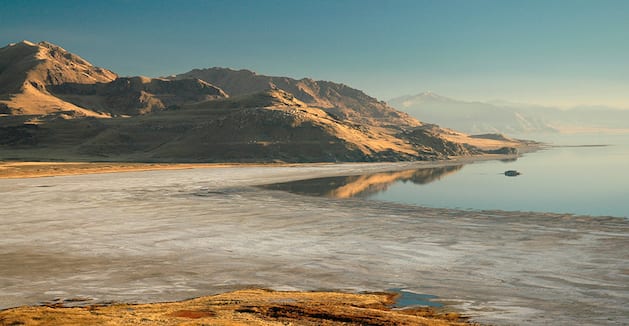Researchers are sounding the alarm: If nothing is done, the Great Salt Lake in the USA could dry up completely within the next five years – the largest salt lake in the western hemisphere then threatens to become a huge salt desert. The consequences for the environment and climate would be significant, because the salt lake also shapes national weather patterns and air currents. The dust from the lake bed, enriched with heavy metals, would also contaminate surrounding towns and fields.
The Great Salt Lake in the US state of Utah is 120 kilometers long, around 50 kilometers wide and originally covers an area of around 4,400 square kilometers, making it the largest salt lake in the western hemisphere. Fed by several rivers, the lake has no outlet but loses large amounts of water through evaporation in the region’s arid, desert climate. This has made its water extremely salty: its salinity can reach as high as 27 percent, just a little below that of the Dead Sea.
But in recent decades, the Great Salt Lake has lost significantly more water than is typical for it – and it could soon dry up completely, as Benjamin Abbott of Brigham Young University in Utah and his colleagues now report. “After millennia of natural fluctuations, human water use has led the Great Salt Lake to structural decline,” they explain.
The Great Salt Lake has already lost around 73 percent of its original water volume, and since 1850 its area has shrunk by 60 percent. In 2022, the lake reached an all-time low, at just 4,188 feet above sea level—the lowest on record. “If water loss continues at this rate, the salt lake will disappear within the next five years,” Abbott and his colleagues said.
The reason for the gradual drying up of the Great Salt Lake is, in addition to climate change and the resulting aggravation of drought, above all man. In order to irrigate fields and obtain drinking water for people and livestock, around 2.5 trillion liters of water are withdrawn from the tributaries of the lake every year, and a further 3.2 trillion liters are lost every year through evaporation from the lake and its shores and wetlands.
However, agriculture accounts for the largest share of water loss: “Irrigation of alfalfa, soybeans and other crops is directly responsible for about three quarters of all water withdrawals,” say Abbott and his colleagues. To save the salt lake, these withdrawals would have to be reduced by 30 to 50 percent. According to the researchers’ calculations, the water inflow into the Great Salt Lake would have to be increased by at least 1.2 trillion liters of water per year if it were not to dry up completely.
However, if nothing happens and the Great Salt Lake disappears, the consequences for nature, people and the climate would be enormous, the scientists warn. “The loss of such a salt lake sets in motion a chain of consequences whose environmental and economic impact is extremely difficult to reverse,” says Abbott. “The collapse of the Great Salt Lake would even affect the entire western hemisphere. Losing him would be a global tragedy.”
Because the Great Salt Lake is not only the habitat for ten million birds and feeds extensive salt marshes, the brine shrimp living in it also form the basis for an entire food network – and also provide food and organic fertilizer for millions of people. “The lake contributes around 2.5 billion US dollars to the economy annually through direct effects,” the scientists report.
There are also indirect effects on the climate and the environment. “The loss of evaporation from the lake can change the regional climate and, for example, promote more extreme temperature fluctuations and drive desertification,” the researchers explain. “Even now, changes in water depth, lake surface and water chemistry can disrupt or destroy local food webs, and even continent-wide consequences are conceivable.
And the drying up of the lake would have another consequence: when its water disappears, a huge area is transformed into a dusty, poisonous desert. The bottom of the lake contains high concentrations of heavy metals such as arsenic, cadmium, mercury, chromium, lead and antimony. There are also organic pollutants and toxins from cyanobacteria. If the lake dries up, the wind can carry these pollutants with the dust far into populated and agricultural areas.
“Overcoming the current water crisis will require unprecedented protective measures,” write Abbott and his colleagues. “Preventing the collapse of the Great Salt Lake is perhaps the greatest challenge our state has faced in its history.” possible to save the Great Salt Lake (Great Salt Lake Report, 2023)
Quelle: Brigham Young University
This article was written by Nadja Podbregar
The original of this article “Great US salt flats have five years left – then serious consequences can be expected” comes from scinexx.








